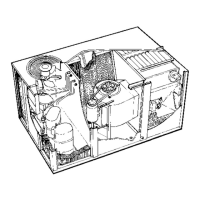Page 67
C1 DIAGRAM WITH B2 DIAGRAM
Electromechanical Thermostat Connected to GCS16-1353 (Without Economizer)
B-GCS16-1353
Operation Sequence: C1 and B2 Sections (electromechanical thermo
stat wired to GCS16-1353)
Power:
1- When the unit disconnect closes, line voltage energizes transformer T1 and
the compressor crankcase heaters. Transformer T1 provides 24VAC power
to unit cooling, heating and blower controls and thermostat. The crankcase
heaters are powered at all times but are selfregulating.
2- Transformer T3 (460V and 575V units) is also energized when power is ap
plied to the unit.
Cooling Demand:
3- On a call for first stage cooling (Y1), demand passes through the first
stage safety limits and energizes contactor K1. Contactor K1 immediately
switches. At the same time, the indoor thermostat energizes the indoor
blower circuit (G). Blower demand passes through blower relays K20 and
K25 to energize indoor blower contacotr K3. K3 immediately switches.
4- When contacts K1-1 close, comrpressor B1 and first stage condenser fan
B4 are energized and immediately begin operating.
5- When contacts K31 close, the indoor blower is energized immediately
and begins operating. When K32 closes, a circuit is completed to the
optional economizer to open the outdoor air dampers to minimum posi
tion.
6- On a call for increased cooling (Y2), demand is passed through the second
stage safety limits to energize contactor K2. K2 immediately switches.
7- When contacts K21 close, compressor B2 and condenser fan B5 are ener
gized and immediately begin operating.
Heating Demand:
8- On a call for first stage heating (W1), demand energizes combustion air
blower relay K13.
9- When contacts K131 close, combustion air blower B6 is energized and im
mediately begins operating. When contactst K132 close, the gas valve is
enabled.
10- As the combustion air blower approaches full speed, combustion air blower
prove switch (S18) closes.
11- When S18 closes a 24VAC circuit is completed through the heating safety
switches to energize burner ignition control A3.
12- When ignition control A3 determines that ignition can begin, A3 simulta
neously sends 24VAC to the first stage operator of the gas valve and to the
indoor blower delay relay (K25) and also sends spark to the spark elec
trode. The gas valve immediately opens and blower delay K25 immediately
begins timing.
13- When flame is sensed by the ignition control, spark is stopped and
the gas valve remains open. If flame is not sensed within the time
allowed, spark is stopped, the gas valve is closed and the ignition
control begins its retrial timing sequence.
14- When blower delay K25 ends its timing period, K251 switches. A
24VAC circuit is completed through K201 to energize blower con
tactor K3.
15- When contacts K31 close, the indoor blower is energized immedi
ately begins operating. When K32 closes, a circuit is completed to
the optional economizer to open the outdoor air dampers to mini
mum position.
16- On a call for increased heating (W2), demand passes through
K202 to energize time delay DL3. DL3 immediately begins its tim
ing sequence.
17- When DL3 time delay has elapsed, DL3 closes internally to complete a cir
cuit to the second stage operator of the gas valve (W2). When gas valve
operator W2 is energized, the gas valve begins to slowly open for second
stage operation.
18- If either heating limit S10 or S21 open during heating operation, ignition
control A3 is immediately deenergized and blower limit relay K20 is imme
diately energized.
19- When A3 is deenergized, the gas valve (W1) and blower delay (K25) are
both deenergized.
20- When K201 switches, blower contactor K3 is energized to continue blower
operation during the time that safety limits are open. When K202 opens,
second stage thermostat demand is prevented from reaching the second
stage operator of the gas valve (W2).

